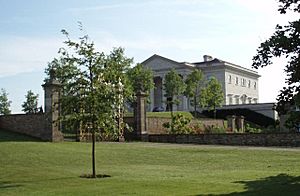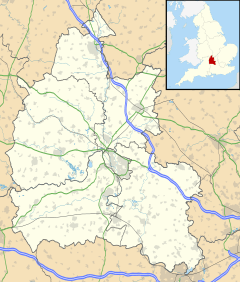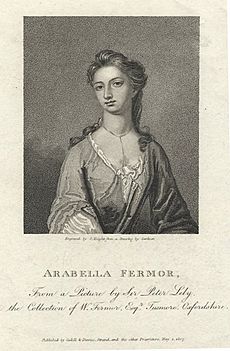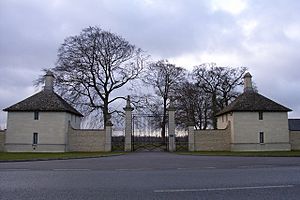Tusmore, Oxfordshire facts for kids
Quick facts for kids Tusmore |
|
|---|---|
 Tusmore - the present house designed by Sir William Whitfield is at least the fourth on the site |
|
| OS grid reference | SP5630 |
| Civil parish |
|
| District |
|
| Shire county | |
| Region | |
| Country | England |
| Sovereign state | United Kingdom |
| Post town | Bicester |
| Postcode district | OX27 |
| Dialling code | 01869 |
| Police | Thames Valley |
| Fire | Oxfordshire |
| Ambulance | South Central |
| EU Parliament | South East England |
| UK Parliament |
|
Tusmore is a small area in Oxfordshire, England. It is about 5.5 miles (9 km) north of Bicester. Tusmore is best known for its large country house and the land around it.
In 1931, only 82 people lived in Tusmore. On April 1, 1932, Tusmore joined with a nearby village called Hardwick. Together, they became "Hardwick with Tusmore."
The Story of Tusmore
Tusmore has been settled since Saxon times, many hundreds of years ago. Its name comes from an old English word. It might mean "Thur's pool" or "a lake where a giant or demon lived."
In 1086, a very old book called the Domesday Book recorded that Tusmore belonged to Walter Giffard. He was the first Earl of Buckingham.
By the early 1300s, Tusmore was a very poor village. Later, many people died or moved away because of the Black Death. By 1358, the village was empty. Sir Roger de Cotesford was allowed to fence off the empty land. In 1428, Tusmore did not have to pay taxes. This shows that fewer than ten families lived there at that time.
The Fermor family owned Tusmore from 1606 until 1828. Their family home, Tusmore House, was there from about 1625 to 1810. In 1828, the last William Fermor passed away without a son. He left the estate to his adopted daughter, Maria, and her husband, John Turner Ramsay.
In 1857, the Ramsays sold Tusmore to Henry Howard, 2nd Earl of Effingham. Later, in 1929, the family of the 4th Earl of Effingham sold it. The new owner was Vivian Smith, a banker. He became the first Baron Bicester of Tusmore in 1938. In the late 1990s, the Smith family sold Tusmore to Wafic Saïd, a very wealthy businessman.
Old Churches and Chapels
Tusmore likely had a church by 1074, and it definitely existed by 1236. After many people left Tusmore in the 1300s, the church became a small chapel. Pieces of stone from the 1400s show it was rebuilt then. It seems to have disappeared by the early 1500s. However, the church's official position continued until 1840. Then, it joined with the church in Hardwick. Today, names like "Church Yard" show where the old church once stood.
The Fermor family were recusants. This means they were Roman Catholics who did not follow the official Church of England after the English Reformation. They kept the Catholic faith alive in Tusmore and nearby villages. The family always had a priest living with them, usually a Jesuit. Many Fermor family members even became priests or nuns. All the Fermor's staff were Catholic. They went to Mass at the Fermor chapel in Tusmore. Other Catholics from nearby villages also joined them.
This continued until 1768, when Tusmore House was being rebuilt. Mass started again after the house was finished. It continued until 1810, when the last William Fermor moved out. His priest then moved to Hardwick. The chapel itself burned down in 1837 and was never rebuilt.
Tusmore Park and Houses
Sir Roger de Cotesford might have built a manor house in Tusmore. That house is gone now. But an old building from the early 1500s still stands. It was used to store grain and house doves. This building is made of oak wood, which is unusual for this area. It is now a Grade II* listed building, meaning it is very important.
The Fermors' house in Tusmore was very large. In 1665, it had 19 fireplaces! It was built from local stone. It also had a Catholic chapel, beautiful gardens, and a fish pond. After 1758, William Fermor had most of the house taken down, except for the chapel. He hired a Scottish architect named Robert Mylne to design a new house. The outside was finished by 1770, and the inside by 1779. Mylne's house had seven sections and was also built from local stone. He also designed the gardens and the park. The park had a lake and a special "Temple of Peace" dedicated to the poet Alexander Pope.
In 1857, the new owner, the 2nd Earl of Effingham, hired another Scottish architect, William Burn. Burn built an office wing where the chapel had burned down in 1837. This was finished in 1858, along with other changes to the house. After 1929, Vivian Smith had the house fixed up. He removed most of the Victorian office wing. Even with these changes, some of the main rooms kept their original 1700s ceilings. Smith also greatly changed the gardens and park. He kept only the Temple of Peace and the lake from Mylne's original design.
In 1960, Randal Smith, 2nd Baron Bicester, had the house taken down. This was seen as a big loss because there were not many important 18th-century houses left in the county. The stables were kept and are now a separate home. In 1964–65, the architect Claud Phillimore designed a new Tusmore House. It was built in a style that looked like older Georgian houses, but it was much smaller than Mylne's house. In 1970, the 2nd Baron died, and his nephew, Angus Smith, became the 3rd Baron Bicester.
In 2000, the new owner, Wafic Saïd, replaced Phillimore's house. He built an even grander house in an Anglo-Palladian style. This new house was designed by Sir William Whitfield. The house has a two-story front entrance and a three-story garden side. In the middle of the house is a three-story round staircase hall. In 2004, a group called the Georgian Group gave this new house an award. They called it the "best new building in the Classical tradition."
Other buildings, gatehouses, and a tall obelisk have also been built for Wafic Saïd. These were all designed by Whitfield Lockwood. As part of big changes to the landscape, a special design of paths has been put back. Also, a wide double avenue of trees now leads from the entrance to the house and ends at the obelisk.




